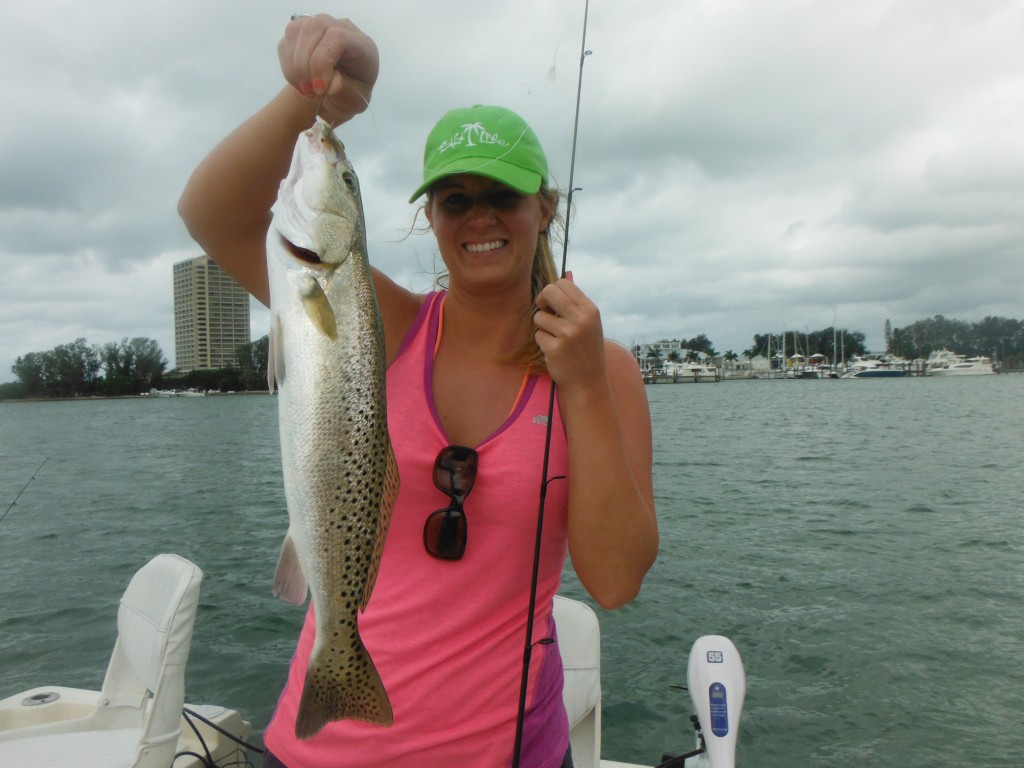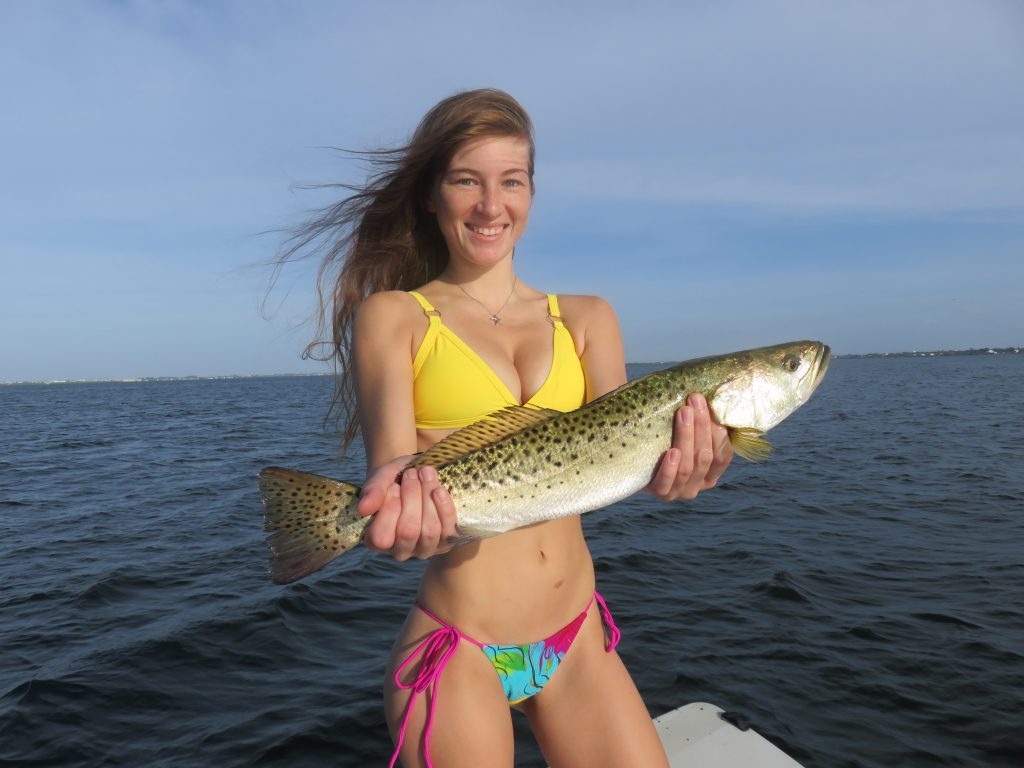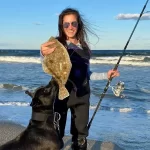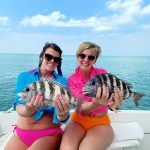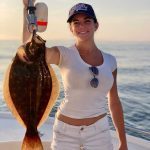17 Productive Spotted Sea Trout Fishing – Pro Tips!
This article on 17 useful spotted sea trout fishing tips will help anglers catch more of these popular inshore saltwater fish. Capt Jim Klopfer has been running fishing charters in Sarasota, Florida, since 1991. Spotted sea trout are one of his favorite species. Capt Jim shares some tips that he has leaned in three decades of fishing for this terrific inshore saltwater species!
Spotted sea trout, known as speckled trout, are plentiful in the inshore waters of the southeastern United States. They are arguably the most popular saltwater inshore game fish species. Spotted sea trout range from Maryland down the East Coast and along the entire Gulf of Mexico. Trout are a beautiful fish that strikes hard, hits artificial lures readily, are usually cooperative, and are terrific eating!
There are quite a few different areas that provide excellent fishing for spotted sea trout. However, the prime areas for both numbers and trophy fish are the bays and flats all along the Gulf Coast. The waters from the Ten Thousand Islands in southwest Florida north and around the coastline to Texas provide perfect habitat for these fish. The abundance of shallow water flats with grass and oyster bottom are perfect for sea trout to flourish.
Spotted sea trout can be caught on a wide variety of artificial lures and live bait. The top live baits are shrimp and small bait fish such as pinfish, grunts, mullet, croakers, and herring. The jig and grub combo is Capt Jim’s favorite artificial lure. Plugs also catch plenty of spotted sea trout. Spoons are another effective lure. Anglers fly fishing catch plenty of spotted sea trout as well.
17 useful spotted sea trout fishing tips
Following is a list of 17 useful spotted sea trout fishing tips. These tips will help anglers understand the local migrations, tips, and tackle that are effective for catching fish.
1) Grass flats hold spotted sea trout
Anglers targeting spotted sea trout will do well to find grass. Submerged grass flats are the prime fish holding habitat for speckled trout. The shallow grass holds bait fish and crustaceans such as crabs and shrimp. This is the main forage for spotted sea trout and other saltwater species. Grass grows in Florida in water up to ten feet deep. Trout will be found at any depth, with the fish being deeper in the cooler and warmer months.
2) Trophy trout are found in shallow water
It sounds like a paradox, but the largest fish are often found in the shallowest water. Large spotted sea trout are often times loners. They abandoned the sanctuary of the large schools to strike it out on their own. Once they reach 20 inches in size or so, they have very few predators. Dolphin, sharks, large birds, and large predator fish are there only true enemies at this point. Therefore, they are more comfortable in shallower water than are the smaller trout. Large schools of smaller trout, between 12″ and 16″, are often found in deeper water on the flats. Capt Jim loves to throw a topwater plug early in the morning on a high tide.
3) Spotted sea trout love shrimp
Shrimp are the primary forage for spotted sea trout for most of their lives. This can be said for many other saltwater species as well. Shrimp are abundant on the flats throughout the southeastern United States. They are rich in protein and are relatively easy prey. Anglers targeting spotted sea trout will do well using live shrimp or artificial lures that imitate shrimp. Many lures including jigs are designed to mimic the erratic motion of a fleeing shrimp. They definitely trigger strikes! Live shrimp are often fished under a noisy popping cork.
4) Large baits will catch trophy fish
As trout grow, they gradually switch their diet from shrimp and crustaceans to large bait fish. Ever the opportunist, large trout will rarely turn down a nice juicy shrimp. However, larger bait fish such as grunts, mullet, croakers, and pin fish become more important parts of their diet. Larger trout will have to feed less often if they can find more substantial meals. Anglers targeting trophy trout will do well using larger hard body plugs, soft plastic jerk baits, and live bait fish. Topwater plugs in particular tend to fool larger spotted sea trout.
5) Popping corks produce a lot of trout
It would be easy to make the argument that more speckled trout have been caught by anglers using a live shrimp under a popping cork than all other methods put together. Popping corks are an incredibly effective technique for trout and other species. It consists of a noisy float, or cork, which makes a popping sound when twitched on the surface. This simulates fish feeding and attracts game fish to the noise. Some corks simply slide onto the line while others require a leader from the cork to the hook.
Anglers can shop at Amazon for a Daiwa Black Gold reel and St Croix Triumph 7′ MF rod spinning combo in this link.
“Fishing Lido Key is a participant in the Amazon Associates Program, an affiliate advertising program designed to provide a means for sites to earn advertising fees by advertising and linking to Amazon. As an Amazon Associate I earn from qualifying purchases.”
Once drawn to the sound of the popping cork, the helpless shrimp just dangling there will usually draw a strike. Anglers will it just the float depth so that the shrimp suspends just above the submerge grass or bottom. Other baits besides live shrimp can be used as well. Many anglers of late have switched to using artificial lures, especially soft plastic baits, under the cork. A small live bait fish can be used as well.
6) Spotted sea trout love the jig and grub combo
The combination of a lead head jig and a soft plastic grub body is without a doubt the number one spotted sea trout artificial lure. Size requirements will vary, however a 1/4 ounce jig with a 3 inch to 4 inch grub is an excellent all-around bait. Anglers can choose a tail that resembles the available forage.
Read more about the best spotted sea trout fishing lures
Soft plastic tails can imitate crabs, shrimp, and bait fish. Shad tail and twister tail bates have a lot of built in action. Capt JIm really likes the Gulp line of baits, particularly the 3″ Gulp Shrimp and 5″ Gulp Jerk Shad. Paddle tail and shrimp tail lures require more of a twitch from the angler. Dark colors work well in darker waters. Light colors perform best in clear water. Bright colors such as pink and chartreuse will stand out in dirty water.
7) Spotted sea trout will bite at night
Lighted docks and bridges will attract shrimp and glass minnows at night. This in turn will attract spotted sea trout and other predator fish. They will lurk in the shadows just outside the light, waiting to pounce on their prey. Strong outgoing tides are preferred. The best approach is to anchor up current and 45° from the light or shadow line. Anglers then cast upstream ahead of the light and allow the current to take the lure or bait to the fish. Most bites will occur in the transition area where the shadow line is.
8) Oyster bars attract spotted sea trout
While many anglers focus on grass beds, and rightfully so, oyster bars are fantastic spots for speckled trout fishing. The best bars will be shallow on one side while dropping off to several feet of water on the other. Most fish will be caught on the deeper edge as the trout cruise in search of food. Low, incoming tides are best as it will concentrate fish in the deeper areas. Spotted sea trout caught near oyster bars are often larger fish.
9) Winter spotted sea trout will seek deep water
Spotted sea trout will school up in big numbers in holes in channels in the winter time. Water temperatures that drop down into the low 50s will send spotted sea trout scurrying for warmer water. This can be the channel of the Intracoastal Waterway, deeper residential canals, holes in the flats, and outside bends and rivers. Passes and inlets will also hold winter trout. A free lined live shrimp is tough to beat. Jigs bounced on the bottom will produce fish as well. Anglers locating such as school can experience incredible, nonstop action!
10) Release tools for spotted sea trout fishing
Anglers targeting spotted sea trout should always have a release tool on board. These are clever little devices with a “j” at the end of them. They allow the angler to slide the tool down and grab the hook, then simply shake the trout off. This is best for the fish as the angler never actually has to put his or her hands on the fish. Spotted sea trout are a bit delicate and need to be handled gently.
11) High tides and top water plugs equal trophy spotted sea trout
Topwater plugs fished over oyster bars and shallow flats on the high tide stage will draw strikes from some large spotted sea trout. This is particularly true early and late in the day or on days where there is cloud cover present. As mentioned earlier, larger speckled trout target larger bait fish. A large top water plug realistically mimics a wounded mullet. This is one of the spotted sea trout’s favorite prey. The Rapala Skitter Prop is one of Capt Jim’s favorite topwater plugs.
12) Tides are important when spotted trout fishing
Like most aspects of saltwater fishing, tides are very important when it comes to targeting spotted sea trout. Many anglers fishing the flats prefer two hours before and after the high tide. Outgoing tides are generally more productive when fishing tidal creeks as well as passes and inlets. Extreme low tides and winter will concentrate trout in holes. However, as long as the water is moving, fish can be located and caught someplace.
13) Plugs are effective baits for spotted sea trout
Plugs are not only effective, they are a lot of fun to fish. They tend to entice larger fish than do jigs and other lures. Top water plugs are great early and late in the day. Shallow diving plugs have an erratic action and are excellent for casting to oyster bars and shorelines. Suspending twitch plugs are deadly when fished over the deeper grass flats. Anglers do need to be mindful of the treble hooks.
14) Live bait fish are terrific for catching spotted sea trout
Live bait fish catch both numbers and quality spotted sea trout. Scaled sardines are very effective in the warmer months. Both grunts, also known as pig fish, and croaker are extremely effective baits for spotted sea trout. They will also generally catch larger than average fish. Both of these fish put out distress sounds when hooked. This is the sound of the dinner bell ringing for spotted sea trout! In shallow water these baits are fished under a float. In deeper water in channels a little weight can be added to get them to the bottom.
15) Locate spotted sea trout by trolling
Spotted sea trout will often times scatter out over a large grass flat. It can take a lot of time for anglers to eliminate unproductive water. This is especially true on days without some wind. Trolling is an excellent technique that can be used to minimize the prospecting time. Spoons, shallow diving plugs, and jigs with a bait fish tail can all be used. Anglers should troll slowly, just above idle speed, over various steps until fish are located.
16) Spotted sea trout will be found in larger numbers over deeper grass flats
Grass flats in water between 4 feet deep and 8 feet deep will hold school sized spotted sea trout. These fish will average between 14 inches and 18 inches long. They will school up by size in fairly large numbers over these deeper flats. The deeper water gives them a sense of security. Anglers seeking numbers of fish and good action will do well casting artificial lures and live bait over these areas.
17) Wading is a productive technique when spotted sea trout fishing
Wading is a very productive shallow water trout fishing technique. Spotted sea trout can be quite spooky in shallow water. Boats make noise, no matter how quiet anglers try to be. Wading allows anglers to quietly and thoroughly work a stretch of water.
In conclusion, this article on 17 productive spotted sea trout fishing tips will help anglers catch more fish!
